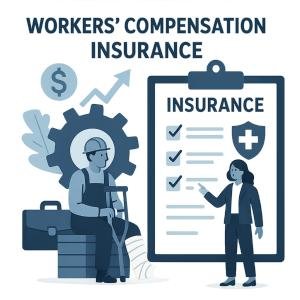
Audit Prep: GA Temp Staffing Agency Workers’ Comp
September 11, 2025
Mergers & Acquisitions: Due Diligence on Workers Comp Liabilities
September 11, 2025In today’s dynamic healthcare environment, managing operational costs while ensuring complete employee protection is paramount. Affordable workers’ compensation insurance has become a critical component for healthcare staffing agencies striving to balance financial sustainability with regulatory compliance and workforce well-being. This article explores strategic approaches to securing cost-effective workers’ comp solutions tailored to the unique risks and demands of healthcare staffing, enabling organizations to protect their staff and maintain competitive advantage in a challenging industry landscape.
Table of Contents
- Understanding the cost Drivers of Workers’ Compensation in Healthcare Staffing
- Strategies for Reducing Workers’ Compensation Expenses Without Compromising Care
- Leveraging Technology and Data Analytics to Manage Workers’ Compensation Risk
- Best Practices for Implementing Effective safety Programs in Healthcare Staffing
- Q&A
- Wrapping Up
Understanding the Cost drivers of Workers’ Compensation in Healthcare Staffing
In healthcare staffing, controlling workers’ compensation costs begins with identifying the primary factors that drive these expenses.High-risk job roles such as nurses, physical therapists, and home health aides are more prone to injuries due to the physical nature of their work, including patient lifting, repetitive movements, and exposure to infectious diseases.Additionally, the frequency and severity of claims can be influenced by workplace safety protocols and the level of employee training. Understanding these elements allows healthcare organizations to tailor risk management programs that minimize claim incidence and reduce overall premiums.
Several critical cost drivers include employee classification,claims management efficiency,and regulatory compliance.For example, misclassifying employees into lower-risk categories can lead to costly audits and retroactive premium adjustments. Below is a concise overview of common cost drivers in healthcare staffing workers’ comp:
- Job classification accuracy: Impact on premium rates and claim assessments
- Injury severity and frequency: Number and costs of medical treatments and lost workdays
- Return-to-work programs: Effectiveness in reducing claim durations
- claims handling: Prompt and thorough investigations to prevent fraud and inflated costs
| Cost Driver | Impact | Mitigation Strategy |
|---|---|---|
| Employee classification | Premium fluctuations, audit risk | Regular job audits & verifications |
| Claim Frequency | Increased premiums | Enhanced safety training programs |
| Claim Severity | Higher medical and indemnity costs | Early injury reporting & proactive care |
| Regulatory Compliance | Penalties & coverage disruptions | Continuous legal updates & compliance audits |
Strategies for Reducing Workers’ Compensation Expenses Without Compromising Care
Effectively managing workers’ compensation expenses begins with a proactive approach that emphasizes employee health and safety without diminishing the quality of care. Implementing rigorous workplace safety training programs and fostering a culture of prevention substantially reduces injury rates. Regular risk assessments, combined with targeted ergonomic interventions, can eliminate common hazards that typically lead to workers’ comp claims. By investing in these preventative measures, companies not only safeguard their employees but also substantially decrease claims frequency and associated costs.
Another critical strategy involves optimizing the claims management process through early intervention and coordinated care. rapid response to workplace injuries ensures timely medical evaluation and treatment, minimizing downtime and long-term disability risks. Collaboration between healthcare providers, case managers, and employers fosters efficient communication and expedites return-to-work programs. Below is a comparative overview of key approaches to reduce workers’ compensation expenses effectively:
| Strategy | Benefits | Impact on Care Quality |
|---|---|---|
| Proactive Safety Training | Lower injury rates, fewer claims | Maintains high care standards |
| Ergonomic Adjustments | Reduced musculoskeletal disorders | Improves worker comfort |
| Early Medical Intervention | Shortened recovery times | ensures timely, effective treatment |
| Return-to-Work Programs | Decreased disability costs | Supports continued care and rehabilitation |
Leveraging Technology and Data Analytics to Manage Workers’ Compensation Risk
In today’s rapidly evolving healthcare staffing industry, implementing advanced technology and data analytics is key to effectively mitigating workers’ compensation costs. By utilizing real-time data tracking tools, organizations can identify high-risk patterns before they lead to claims.Technology enables the continuous monitoring of workplace conditions and employee health indicators, allowing for proactive interventions and tailored safety programs. Integrating these solutions helps streamline claims processing and reduce administrative overhead, ultimately driving down overall workers’ compensation expenses.
Key benefits include:
- Improved injury prediction through predictive analytics
- Enhanced employee risk assessments using biometric data
- Automated reporting and compliance tracking
- Cost-efficient claims management via data-driven insights
| Technology | Function | Impact on Risk Management |
|---|---|---|
| Wearable Sensors | Monitor worker movements and fatigue | Reduce occurence of musculoskeletal injuries |
| AI-Driven Claims Analysis | Analyse claim patterns for fraud detection | Lower fraudulent claim rates and costs |
| Risk Analytics Platforms | Assess and forecast workplace hazards | Enable preventive safety measures |
Best Practices for Implementing Effective Safety Programs in Healthcare Staffing
Establishing a robust safety culture within healthcare staffing agencies demands a proactive approach centered around comprehensive training, clear communication, and continuous risk assessment. Organizations should implement regular safety drills and workshops that focus on common workplace hazards such as patient handling, exposure to infectious diseases, and ergonomic injuries. These efforts ensure staff are equipped not only with the skills but also the confidence to adhere to safety protocols. Furthermore, fostering open channels for reporting incidents without fear of reprisal encourages openness and effective resolution of potential safety risks before they escalate.
Accomplished programs hinge on a strategic integration of policies and practical tools tailored to the unique demands of healthcare environments. Consider incorporating technology-driven solutions like digital incident tracking systems and mobile safety checklists to maintain real-time oversight. The following table reflects essential components and their practical benefits for a healthcare staffing safety initiative:
| Key Component | Benefit |
|---|---|
| Regular Safety Training | Enhanced compliance and reduced accidents |
| Incident Reporting System | Improved hazard awareness and timely interventions |
| Personal Protective Equipment (PPE) Policy | Lower exposure to infectious and physical risks |
| Employee Wellness Programs | Boosted morale and reduced workplace stress injuries |
Q&A
Q&A: Affordable Workers’ Comp for Healthcare staffing
Q1: What is workers’ compensation and why is it crucial in healthcare staffing?
A1: Workers’ compensation is a form of insurance that provides wage replacement and medical benefits to employees injured on the job. In healthcare staffing, it is indeed critical as healthcare workers frequently enough face high-risk environments, including exposure to infectious diseases, physical strain, and patient handling.Proper workers’ comp coverage ensures financial protection for both staff and employers while promoting workplace safety.
Q2: Why is affordability a key concern for healthcare staffing agencies when it comes to workers’ comp?
A2: Healthcare staffing agencies typically operate with tight margins and manage fluctuating client demands. High workers’ comp premiums can significantly increase operating costs, affecting competitiveness and profitability. Affordable workers’ comp enables agencies to maintain compliant coverage without sacrificing financial stability or staffing quality.Q3: What factors influence the cost of workers’ compensation insurance for healthcare staffing agencies?
A3: Key factors include the level of risk associated with specific job roles, the agency’s claims history, safety protocols in place, geographic location, and the agency’s payroll size. Agencies with strong safety programs and low claim incidences often qualify for reduced premiums.
Q4: How can healthcare staffing firms reduce their workers’ comp premiums without compromising coverage?
A4: Agencies can implement robust workplace safety training, enforce strict compliance with OSHA standards, proactively manage claims, and invest in ergonomic equipment to reduce injury risk. Partnering with insurance carriers learned about healthcare staffing nuances can also secure more affordable, tailored policies.
Q5: Are there specialized workers’ comp insurance products designed for healthcare staffing agencies?
A5: Yes. Many insurers offer customized workers’ comp solutions that address the unique risks and workforce dynamics in healthcare staffing. These products often include flexibility in coverage options, competitive rates based on risk profiles, and value-added services such as risk management consultation.
Q6: What role does compliance play in managing affordable workers’ compensation for healthcare staffing?
A6: compliance with state and federal workers’ compensation laws ensures agencies avoid costly penalties and litigation. Maintaining accurate employee classification and timely reporting helps prevent premium audits and potential rate increases.Compliance also strengthens the agency’s relationship with insurers, contributing to more favorable insurance terms.
Q7: How can technology improve workers’ comp management for healthcare staffing agencies?
A7: Technology platforms can streamline injury reporting, track claims in real time, and facilitate communication between staff, clients, and insurers.Data analytics can identify risk trends and help agencies implement targeted safety interventions, ultimately reducing claims and associated premium costs.
Q8: What should healthcare staffing agencies look for when selecting a workers’ compensation insurance provider?
A8: Agencies should prioritize carriers with industry expertise, responsive claims handling, competitive pricing, and comprehensive coverage options. Providers offering proactive risk management support and flexible policy structures are particularly beneficial in the dynamic healthcare staffing market.
Q9: How does affordable workers’ compensation contribute to the overall success of healthcare staffing agencies?
A9: Affordable workers’ comp protects agency finances by mitigating unexpected costs, supports employee wellbeing through prompt injury care, and enhances client confidence with reliable staffing solutions. Together, these factors foster operational stability, reputation growth, and long-term viability in a competitive market.
this Q&A aims to provide healthcare staffing professionals with a clear understanding of affordable workers’ compensation strategies, emphasizing compliance, risk management, and cost-efficiency.
Wrapping Up
in today’s competitive healthcare landscape, securing affordable workers’ compensation is essential for staffing agencies striving to maintain both compliance and financial stability. By leveraging tailored coverage options and partnering with experienced insurers, healthcare staffing firms can effectively manage risks while safeguarding their workforce.Embracing cost-efficient workers’ comp solutions not only protects employees but also supports lasting growth, enabling staffing providers to focus on delivering quality care with confidence and peace of mind.
“This content was generated with the assistance of artificial intelligence. While we strive for accuracy, AI-generated content may not always reflect the most current information or professional advice. Users are encouraged to independently verify critical information and, where appropriate, consult with qualified professionals, lawyers, state statutes and regulations & NCCI rules & manuals before making decisions based on this content.







